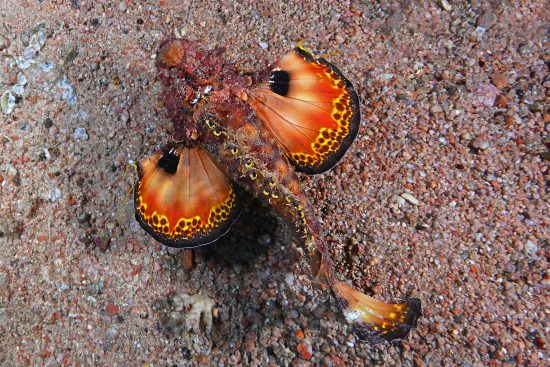




The spiny devilfish (Inimicus didactylus) is a venomous marine fish of the Synanceiidae family. This family also includes stonefish, which are considered some of the most venomous fish in the world, and similar species.
This fish has many names: Red Sea Walkman, Goblinfish, Demon Stinger, Devil Stinger, Devil Scorpionfish, Demon Rockfish, Popeyed Sea Goblin, Bearded Ghoul and Indian Walkman.
Spiny devilfish are widely distributed around the world, from the Indo-Pacific region, including the Red Sea, East Africa and Japan to northern Australia.
They typically inhabit shallow waters around 10m. Still, they can venture as deep as 100 meters and are found in various environments, including sandy or muddy substrates, seagrass beds and coral reefs.
These fish can grow up to 25 cm and look a little chunky with a wide head and flattened body. They are highly variable in colour and can include shades of yellow, brown, and red. This range of colours helps them blend into their surroundings on the seabed. Their excellent camouflage abilities make them difficult to spot, which is both a defensive strategy against predators and an offensive strategy for catching prey.
The spiny devilfish has large, fan-like pectoral fins that are often brightly coloured and can be spread out to startle predators or to display during mating rituals. Their specialized pectoral fin rays function almost like legs, allowing them to "walk" along the seabed, a unique adaptation among fish.
Spiny devilfish have numerous venomous spines along their dorsal fin, which they use to defend against potential predators. They are carnivorous and feed primarily on small fish and invertebrates. They are ambush predators, relying on their camouflage to surprise prey. They are generally slow-moving and prefer to remain stationary, blending into their environment to avoid detection by both prey and predators.
Spiny devilfish are mostly nocturnal, coming out at night to hunt for food. During the day, they often bury themselves in the sand to avoid detection. They can be quite territorial, using their venomous spines and threatening displays to deter intruders from their chosen hiding spots.
As ambush predators, spiny devilfish play a crucial role in controlling the populations of small fish and invertebrates. They are also preyed upon by larger predators, including some species of sharks and larger fish.
Because they are sensitive to changes in their environment, spiny devilfish can act as indicators of the health of the environment.
The conservation status of spiny devilfish has not been extensively studied, and they are not currently listed as endangered or vulnerable , however, human activities such as coastal development, pollution and overfishing can affect their habitat.
Very little is known about their specific mating behaviours, but like many reef fish, they likely engage in seasonal spawning, where females release eggs into the water to be fertilized by males. The fertilized eggs become part of the plankton and drift with the currents until they hatch. The larvae are also planktonic until they mature enough to settle on the seabed.
To humans, contact with the venom can cause severe pain, swelling, and even more serious systemic effects. If stung by a spiny devilfish, immediate medical attention is required. Immersing the affected area in hot water can help reduce pain and inactivate some of the venom's components, but professional medical treatment is essential.
The spiny devilfish's unique adaptations and potent venom make it a fascinating yet dangerous marine creature that should be admired from a safe distance.
>>Did you know, you can discover more about sealife with one of SSI's Environment Specialty programs. Find out more here!<<
 Ivana and Janez
Ivana and Janez 14th August 2024
14th August 2024